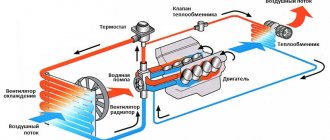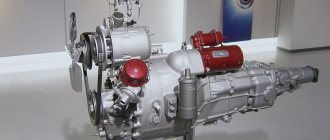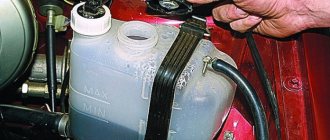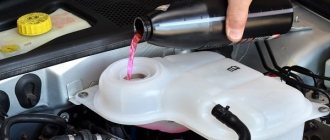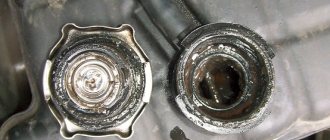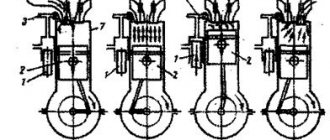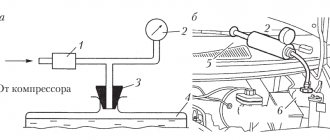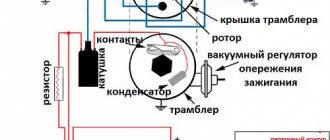The cooling system on the VAZ 2114 and other Zhiguli models often fails. Therefore, the owner needs to know its structure and all its elements in order to correctly and timely diagnose the malfunction. This article presents a diagram of the VAZ 2114 cooling system (8 valves, injector) and describes its most important components.
Useful : How to remove air from the cooling system on Samara 2
How the OS works
The cooling system of the VAZ 2114 operates on the basis of internal heat exchange, which is carried out under the influence of coolant. It moves forcibly thanks to a pump, which is activated by a drive belt. The mixture enters the OS through the expansion tank.
The electric fan is located on the electric motor shaft. Depending on the indicators of the sensor, it is turned on or off. One of the main elements of the OS is a thermostat valve with a storage tank , which senses changes in air temperature.
If the fluid temperature is around 87 degrees, the main valve turns on and sends fluid through the large circuit. At a temperature of 102 degrees, the valve stops at 8 mm.
Internal heat exchange
The operating principle of the VAZ 2114 engine cooling system is based on internal heat exchange, which occurs using liquid. I won’t reveal anything new to you here, since the operation of the cooling systems of 99% of all cars in the world is based on this principle.
The reason for this was that this principle is much more efficient and reliable than the air cooling system.
We are all familiar with the legend of the domestic automobile industry, the Zaporozhets car, on which the engine stood at the rear and was cooled using directed air flows.
Zaporozhets engine.
And how the owners of this car suffered, coming up with various tricks to increase the efficiency of this system so that the engine does not overheat.
Replacing the coolant
To normalize the cooling system on a VAZ 2114, sometimes it is enough to replace the coolant. To determine when this needs to be done, you should know some nuances:
- The effective life of antifreeze is 2 years, and antifreeze is 5 years;
- Typically, replacing antifreeze is required after a mileage of 20-40 thousand kilometers, depending on operating conditions;
- A changed color of the composition indicates that it needs to be replaced.
antifreeze as a liquid , since it has a long service life and does not wear out the system so intensively. in favor of antifreeze is its affordable price.
Before adding new fluid, the system should be flushed. For this:
- Drain all existing coolant from the system;
- Screw the plugs tightly;
- Fill with high-quality distilled water to the maximum;
- Start the engine and bring it to operating temperature;
- The revolutions should be about 3 thousand. Avoid overheating the engine;
- After turning off the engine, leave the car for 7 minutes, after which the water is drained. If the system is heavily contaminated, the procedure must be repeated until completely clean distillate begins to pour out.
HOW TO CHANGE THE STOVE TAP WITH YOUR OWN HANDS?
You will need a pit to work with because the heater valve is located at the bottom of the hood, under the side trim on the passenger side. Replacing the stove valve on a VAZ 2114 is carried out in several stages:
- On the faucet, you need to brush the fasteners, rinse them with brake fluid, and leave them for a while so that the fluid cleans the threads on the studs and the nuts are easier to unscrew. To wash studs, it is better to use WD-40, if available. This is an important stage in the work, because rusted bolts can grab the nut so much that unscrewing them becomes problematic. Sometimes when unscrewing nuts, the bolts need to be held with an additional wrench or pliers.
- In the cabin, remove the side trim. Now you can see the pipes leading to the tap. Loosen the hose clamps and remove the hoses one by one. At the same time, keep a container with antifreeze near you, which you immediately place under the emptied pipes so that the remaining antifreeze flows out.
- If you decide to replace the hoses, they must also be released from the radiator. But if they are in satisfactory condition, then when you start assembling, you will only need sealant.
- Return to the pit and use a 10mm wrench to unscrew the nuts holding the tap in place.
- Go back to the body again and try to remove the heater valve of the VAZ 2114 towards the passenger seat. In this position, remove the lock and release the cable that controls the tap.
- Now you can install the new faucet. First put the cable on it, secure it with a spring clip, and only then can you screw it into place. Install O-rings between the valve and the body. Use sealant to secure the stove pipes in place. Don't forget to pour the antifreeze back into the radiator at the end.
Replacing the stove valve of the VAZ 2115, as well as the VAZ 2113, is carried out in the sequence described above. The design of the heater in these VAZ models is the same as that of the VAZ 2108.
Why the OS does not work
The cooling system most often stops working due to improper operation of the thermostat. You can't do anything other than replace it.
If you don’t know which cooling radiator is best to choose for the VAZ 2114, look at the existing one. Buy an analogue from the manufacturer, or purchase a device with the closest characteristics.
The fourteenth model is equipped with an aluminum radiator with two additional tanks. The radiator design includes:
- Radiator;
- Upper tank with pipes;
- Bottom tank with pipes.
Radiator replacement
If there is a need to replace the radiator, remember the first golden rule - the engine must be cold before dismantling the device. Therefore, if you just arrived at the garage, let the car sit for a couple of hours. Better yet, leave the car and come back tomorrow.
The replacement procedure itself is as follows.
- Unscrew the plug from the expansion tank and the cylinder and radiator plugs.
- Drain the coolant into a large container.
- Disconnect the radiator ventilation system from the battery.
- Remove the silicone pipes of the VAZ 2114 cooling system by disconnecting them from the radiator and tank.
- Remove the mounting bolts from the casing.
- Hold the radiator and remove the skin and fan together.
- This will completely free the radiator, so you can easily replace it with a new one.
- Assembly of the unit is carried out in reverse order. After replacing the radiator, start the engine and check the efficiency of the new unit.
Repair of VAZ 2114 stove
To repair the stove, it is necessary to remove it and then make the necessary adjustments.
VAZ 2114 stove diagram
VAZ 2114 stove diagram
- Before removing the heater (1), be sure to remove the wire going to ground, and the coolant must be drained in advance.
- Carefully remove the dashboard, and with careful movements disconnect the air duct (19) through which air enters the car interior.
- The next step of the work will be to conduct an audit of the electrical system: checking the wires of the resistor (18), fan, electric motor (2), hoses of the outlet valve (13 and inlet valve (12).
- On the shield, 2 nuts securing the tap are removed in sequence.
- Carefully remove the seal from the tap pipes.
- The nuts securing the stove to the body are removed.
- As a result, the heater can be removed.
- After making the necessary adjustments, installation is carried out using the same method but in reverse order.
Radiator repair
In some cases, the radiator can be repaired, so you don’t have to buy a new spare part.
Mostly repair work consists of eliminating leaks that have arisen as a result of defects, cracks and holes.
Most often, liquid leaks at the junction of plastic and metal parts. If there is a small leak, you can pour a special liquid with a coolant mixture inside the radiator. Thanks to its special composition, this product will seal the defects that caused the leak. If the damage is serious, repairs will no longer save the situation; you will still have to replace the radiator.
To check the tightness of the radiator, you can conduct a simple experiment at home.
- Fill the bathroom with enough water to submerge the radiator.
- Close all pipe openings tightly.
- Lower the radiator under water about 30-50 centimeters. Apply a pressure of 0.2 MPa to it.
- Watch what happens. If bubbles appear, the system is not sealed and needs to be repaired or replaced.
Do not even try to repair the radiator after side or frontal impacts in an accident. In such situations, he suffers first of all, and no clogging liquids will help you.
Thermostat problems
The thermostat sensor is responsible for maintaining the required system temperature. It allows you to close the access of coolant inside the radiator until the engine warms up to the optimal temperature. It is about 90 degrees Celsius.
When the temperature reaches 95 degrees Celsius, the liquid begins to flow through the thermostat. Due to the operation of this unit, the engine requires a minimum of time and resources to warm up. The thermostat is located between the radiator and the engine.
Most often there are two types of faults.
- The valve closes. If the engine is not warmed up, it is difficult to maintain speed. It may simply stall.
- The valve opens. During frosty periods, you can operate the car, but you must turn on the heating at maximum speed. Otherwise, the power unit will simply overheat.
If you are unable to move the valve while repairing the thermostat, don't be afraid to lightly tap the housing with a simple screwdriver. This will solve a common problem.
Tags: 2114, cooling system
Comments 71
What if the bottom one is warm?
You don’t need to do anything (otherwise they will advise you to disassemble the car) everything works fine, you just don’t need to turn on the heater until the engine is completely warmed up when parked at idle speed, because the outside air at -17 degrees, passing through the radiator of the heater, does not he needs to warm up properly. It turns out that the cooling of your engine is already at the highest level, so you don’t need to flush anything, change the pump, etc.
Flush the system, change the pipes that require replacement and take a closer look at the pump, most likely it needs to be changed, it does not create pressure in the system, it will require investments for a long time and warmth
I have a problem with the pump, it’s time to change it and I think that the impeller is ruined. It doesn't move fluid well. While at idle the coolant barely moves at all, you accelerate at 3 thousand revolutions at once and the stove heats up and the pipes all warm up. I removed the hose from the throttle heating from there when it warms up, fluid should flow, but it only starts to flow when you accelerate, also not okay on another car, it goes on its own on mine no
I installed a LADA SPORT pump - the result is excellent.
I have a problem with the pump, it’s time to change it and I think that the impeller is ruined. It doesn't move fluid well. While at idle the coolant barely moves at all, you accelerate at 3 thousand revolutions at once and the stove heats up and the pipes all warm up. I removed the hose from the throttle heating from there when it warms up, fluid should flow, but it only starts to flow when you accelerate, also not okay on another car, it goes on its own on mine no
First, make the system airtight and then watch.
1. Thermostats come in 6 and 5 holes - you need a 6 hole. 2. The system may be air-filled - unscrew BOTH! throttle heating pipe and add antifreeze to both. 3. Before adding antifreeze, it was necessary to flush the system from scale... I do it like this:
a) pour hot water from the tap into the system and add 2 bottles of vinegar. we drive actively on this thing for 1 hour... we drain this crap onto the generator :) better, of course, not on it...
B) To prevent the antifreeze from curdling from vinegar residues, fill the system with clean water, having previously dissolved a handful of washing powder in it.
C) rinse again with distilled water - clean from the pharmacy - it costs 2 kopecks.
D) Drain the water and fill it with Antifreeze - voila - the stove burns your fingers.
try changing the temperature sensor
Install a 6-hole thermostat from a VAZ 2110. And in general you will be happy and warm on the highway. Now I’m driving on the highway with a temperature of 91 degrees, the tropic in BC is set to 96. Previously, it never rose above 82 degrees.
The heater takes the heated liquid from the engine and sends it to the pump; by the time the pump runs, it has already cooled down and so on continuously until everything has warmed up, because of this the engine takes a long time to warm up and cool down when you turn on the heater in your mouth, replacing the hoses, you will end up with the engine and radiator being one whole. This kind of modification was made back in 1999 by the magazine Behind the Wheel. And only now they started doing this when they started making the Chevrolet Niva
“If you replace the hoses, you will end up with the engine and radiator being one.” What did you mean, just some kind of typo...
And the stove heats up equally with the engine. I start the car from autostart and the heater is on. After about 5 minutes I sit down and the engine has warmed up to 55-60 degrees and warm air is blowing from the stove.
Swap the expansion tank hose and the heater outlet. You can also cut down the thermostat rod and then it will be more than 85. I had the same problem myself. And now it’s 87 g. It even holds my face; I don’t cover it with anything, even sometimes I turn down the heat; I can’t breathe
It's fine with the heater on. That's why I don't open it until 70C. Then I opened it and warm air came out immediately. Last winter at -15C it warmed up to 40 minutes in 7-8 minutes this way
For this temperature outside, this is normal engine warming up, don’t worry
Well, it’s normal if the heater is turned on immediately after starting the engine, then of course it will take a long time to warm up. It’s easy to check the thermostat, warm up the car to 50-60 degrees and touch the lower radiator hose, it should be cold, the upper one should be warm, if both are warm, then the thermostat does not close completely, repair or replacement
everything works well, it comes off at 85 degrees, I'm interested in specific heating in a small circle
70-80 degrees in 15 minutes with the stove on - this is normal in cold weather
with the heater on it will be 50-60 (-17 overboard)
Damn, we don’t have such frost now, otherwise I would tell you what temperature it’s heating up to)
DIAGRAM AND DEVICE OF THE COOLING SYSTEM
The cooling system of the VAZ 2114 is liquid, with forced circulation. Antifreeze or antifreeze is poured into the system as a coolant. In the most extreme case, you can fill it with water, but you can’t drive it for a long time - in winter you can defrost the engine, and during the rest of the season, when the engine is used for a long time on water, the cooling jacket in the block and cylinder head is corroded, and rust accumulates in the radiator.
The VAZ 2114 engine cooling system (SOD) consists of the following elements:
- Radiator. It is the main cooling part in the system and performs the function of transferring heat to the liquid into the surrounding airspace;
- Water pump (pump). The pump creates forced movement of antifreeze in the system, thereby cooling the entire SOD, including the internal combustion engine (ICE). The pump rotates from the timing belt;
- Branch pipes (hoses). Antifreeze circulates through them;
- Thermostat. It regulates the passage of coolant through all pipes or only in a small circle and maintains the required operating temperature of the internal combustion engine;
- Electric fan. The fan is located on the plane of the radiator and, due to the air flow created, cools its surface when turned on. The electric motor turns on only when the temperature set by the sensor is reached (103°C);
- Expansion tank. Liquid is poured into the tank, and when the fan is activated, antifreeze flows into it through the return hose, thereby releasing excess pressure into the SOD;
- Expansion tank plugs. There are valves in the plug that relieve excess air pressure created in the system when antifreeze circulates.
Technology for removing the throttle valve assembly
During operation of the VAZ 2114, the engine cooling system may begin to work incorrectly. There can be many reasons, one of which is air in the throttle assembly.
To troubleshoot problems, it is necessary to remove the part to remove air, clean the valve, rinse it or install a new one; removal may also be necessary to replace the gasket in the throttle assembly. If the idle air control (IAC) is held on by varnish, then to remove it, you also need to remove the throttle valve. If the cooling system of the VAZ 2114 operates intermittently, then a possible cause may be an air lock in the throttle assembly. If you follow the recommendations for operating the car (manual), then it is necessary to drain the coolant when removing the unit. But there are methods that eliminate this procedure. The loss of fluid with them will be no more than 200 grams. It is important to know! Before starting work, be sure to wait until the engine has completely cooled down, otherwise this may result in a burn from the coolant. Tools. • Flat blade screwdriver; • Cross; • Container (plastic liter bottle with a cut neck); • Socket wrench, size “13”; • M13 bolts – two pieces.
COOLING SYSTEM PROBLEMS
As a rule, due to malfunctions in the cooling system, the engine overheats, and this leads to engine failure. Any of the elements may be faulty.
- It may leak. Possible leakage through aluminum tubes and plastic tanks. Often the plastic outlet for the return hose of the expansion tank breaks off.
- It may clog, and for this reason the engine will heat up.
Pipes. Because of them, antifreeze leaks due to the fact that the pipe:
- Ragged.
- Old and lost elasticity.
Thermostat. Depending on how incorrectly the valve in the thermostat operates, the internal combustion engine can:
- Overheat (in this case, the antifreeze “throws out” through the expansion tank).
- Do not reach operating temperature. As a result, the car drives poorly, and in cold weather it is cold inside the car.
Water pump (three main problems):
- Noise and play in bearings. It is not worth driving with such a defect for a long time; the pump may jam or fall apart.
- Liquid is leaking through the inspection hole. It also signals the imminent “death” of the part.
- Broken impeller. With such a defect, the engine overheats very quickly.
- A faulty fan also leads to overheating of the internal combustion engine.
The clamps may be faulty or poorly tightened. It happens that thin hoses become clogged with debris (“return”, throttle valve heating).
REPAIR OR REPLACEMENT OF RADIATOR
Let us consider in detail the features of the work.
RINSE
Replacing the cooling radiator is required if the internal combustion engine heats up due to its clogging. But before changing it, you can try flushing the cooling system of the VAZ 2114 engine. Often flushing helps, and the engine stops heating up. We perform washing as follows:
- We park the car on a level surface;
- Unscrew the expansion tank cap;
- Drain the coolant from the radiator by unscrewing the bottom plug;
- We unscrew the water plug from the cylinder block (it is located between the internal combustion engine and the fan in the starter area) and drain the antifreeze from the block;
- We wrap the plugs and fill the system with plain clean water;
- Let the engine run and drain the water. If the water that comes out is dirty, repeat the flushing. We repeat the procedure several times until the draining water becomes clear;
- After flushing, fill in new coolant. It should be noted that the volume of the VAZ 2114 cooling system is 7.8 liters, and if all the antifreeze is not included in the system, most likely an air lock has formed in it. It is necessary to fill the container as much as possible to avoid overheating of the internal combustion engine.
It is often recommended to do the flushing on a cold engine to avoid being scalded by hot antifreeze. On the one hand, it seems to be true, but in cold weather all the dirt will settle on the walls of the SOD, and the washing efficiency will not be so great. And don’t wait every time for the water to cool down. You just need to drain the coolant carefully and work in thick, waterproof clothing and gloves. You also need to remember that the shelf life of antifreeze and antifreeze ranges from 2 to 5 years.
REPLACEMENT
Replacing the cooling radiator on a VAZ is very simple:
- Remove the expansion tank plug;
- Drain the antifreeze from the radiator and cylinder block. It is necessary to prepare a container for liquid in advance;
- We dismantle the air filter housing, it will interfere with removing the radiator;
- Disconnect the electric fan plug, unscrew the two bolts securing it and dismantle the unit;
- We loosen the clamps where it is more convenient and pull off the pipes;
- In the upper part of the radiator, remove the two bolts securing it to the body frame, tilt its body towards the engine and remove the part. Radiator removal is complete;
- We reassemble in the reverse order, then fill in antifreeze and start the engine.
REPAIR
If you wish, you can make minor repairs to the engine cooling yourself, but more often they repair it as a necessary measure:
- If you need to get to some destination;
- In the case when they did not expect a replacement and there is no money yet.
Plastic tanks can be sealed with epoxy resin or soldered; against leakage through the honeycombs, a special chemical composition is used, which is added to the antifreeze and clogs the leaking areas. But it is possible that such chemistry will complicate the passage of coolant throughout the system.
It’s easier not to be tricky with the radiator, but to replace it, especially since it is inexpensive, somewhere from 1,200 rubles.
Therefore, do-it-yourself repairs often become economically unjustified, and a lot of time is spent on useless “treatment.” True, there are more expensive copper radiators, but they are easier to repair - copper can be soldered.
Repairing the thermostat is hardly advisable; it is better to replace such a part immediately. Moreover, it costs about 350-500 rubles.
Causes of malfunction of the VAZ 2114 stove
- The heater on a VAZ 2114 is leaking. In this situation, it is cheaper and easier to purchase a new radiator. Despite the fact that the hole may be small in size, the radiator will no longer be able to fully perform its functionality and fully comply with the presented characteristics. Of course, if you seek qualified help from a specialized service, the malfunction will certainly be eliminated, but this is not a solution to the problem, because a short period of time will pass and the defect will reappear, given that the amount of repair is not so small.
- The VAZ 2114 radiator is clogged. In this situation, there is a chance to give the radiator a new life if proper repairs are carried out. But before repairing it, it must be removed. Cleaning can be done using KARCHER or by blowing with compressed air. But this process must be carried out very carefully, because... The radiator may not withstand high pressure and will simply break as a result. And then you will definitely have to buy a new one to replace it.
- Motor failure. This problem occurs as a result of a damaged fuse. Solving this problem is quite easy; a failed fuse simply needs to be replaced. But perhaps this is not enough to solve this problem. The question arises, why did the fuse blow? Most likely, a short circuit has occurred in the wiring; to prevent a repeat situation, the best solution would be to “ring” the entire circuit to identify the system flaw and then eliminate it. Otherwise, if things go badly, a short circuit may occur, with negative consequences.
On VAZ 2114 models, the fuse is class F7 and has a current of 30A. It is additionally responsible for the cigarette lighter circuits, built-in lighting in the glove compartment, and heated rear window. If the cause of the malfunction lies in the fuse, this can be determined in the early stages.
If the cause is not the fuse, make sure that the fan is receiving voltage; use a multimeter to check. Or the reason is in the incoming wires indicating a weak contact.
- Poor contact inside the mounting block. This is a fairly common drawback of these models. It is imperative to check all available contacts in the unit; there is a possibility of oxidation or poor-quality connection, as a result the circuit breaks, which negatively affects the operation of the fan.
- Water in the ignition relay. The radiator starts working when the car is warm, this is directly related to the evaporation of water in the relay, only after this the relay works.
- The interior of the VAZ 2114 is poorly heated. Despite the fact that the 2114 stove, according to the first signs, supplies warm air to the cabin, the engine is also heated up to 90 degrees, however, the air in the cabin is not warmed up enough. Here you need to unscrew the side of the torpedo from the passenger side and check the two hoses coming from the stove; if they are cold, then the reason is that they are clogged. It is enough to clean them with simple manipulations.

